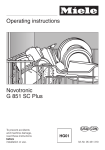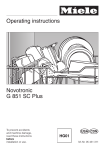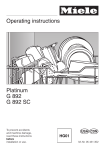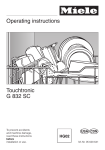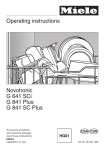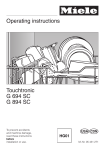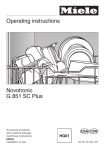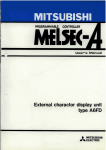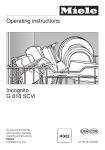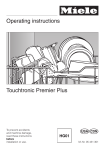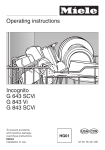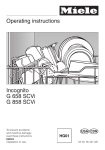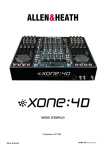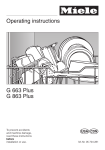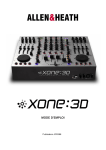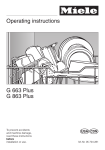Download Miele NOVOTRONIC G 856 SC ELITE Operating instructions
Transcript
Operating instructions Novotronic G 856 SC Elite To prevent accidents and machine damage, read these instructions before installation or use. UV M.-Nr. 05 431 320 2 Contents IMPORTANT SAFETY INSTRUCTIONS MESURES DE SÉCURITÉ IMPORTANTES Caring for the environment Energy saving washing . . . . . . . . . . . . . . . . . . . . . . . . . . . . . . . . . . . . . . . . . . . . . . 9 Guide to the dishwasher Wash cabinet . . . . . . . . . . . . . . . . . . . . . . . . . . . . . . . . . . . . . . . . . . . . . . . . . . . . . 10 Control panel . . . . . . . . . . . . . . . . . . . . . . . . . . . . . . . . . . . . . . . . . . . . . . . . . . . . . 11 Before using for the first time To open the door . . . . . . . . . . . . . . . . . . . . . . . . . . . . . . . . . . . . . . . . . . . . . . . . . . 12 To close the door . . . . . . . . . . . . . . . . . . . . . . . . . . . . . . . . . . . . . . . . . . . . . . . . . . 12 Child Safety Lock . . . . . . . . . . . . . . . . . . . . . . . . . . . . . . . . . . . . . . . . . . . . . . . . . . 12 Water softener . . . . . . . . . . . . . . . . . . . . . . . . . . . . . . . . . . . . . . . . . . . . . . . . . . . . 13 Programming the water softener . . . . . . . . . . . . . . . . . . . . . . . . . . . . . . . . . . . 14 Checking the programmed water hardness . . . . . . . . . . . . . . . . . . . . . . . . . . . 15 Salt indicator . . . . . . . . . . . . . . . . . . . . . . . . . . . . . . . . . . . . . . . . . . . . . . . . . . . . . 17 Rinse aid . . . . . . . . . . . . . . . . . . . . . . . . . . . . . . . . . . . . . . . . . . . . . . . . . . . . . . . . 18 Adding rinse aid . . . . . . . . . . . . . . . . . . . . . . . . . . . . . . . . . . . . . . . . . . . . . . . . . . 18 Adjusting the dosage. . . . . . . . . . . . . . . . . . . . . . . . . . . . . . . . . . . . . . . . . . . . . . . 19 Rinse aid indicator . . . . . . . . . . . . . . . . . . . . . . . . . . . . . . . . . . . . . . . . . . . . . . . . . 19 Loading the dishwasher Items not recommended for dishwashing . . . . . . . . . . . . . . . . . . . . . . . . . . . . . . . 21 Cutlery tray (SC units) . . . . . . . . . . . . . . . . . . . . . . . . . . . . . . . . . . . . . . . . . . . . . . 22 Upper basket . . . . . . . . . . . . . . . . . . . . . . . . . . . . . . . . . . . . . . . . . . . . . . . . . . . . . 23 Adjusting the upper basket . . . . . . . . . . . . . . . . . . . . . . . . . . . . . . . . . . . . . . . 23 Adjustable cup racks . . . . . . . . . . . . . . . . . . . . . . . . . . . . . . . . . . . . . . . . . . . . 24 Coffee bar . . . . . . . . . . . . . . . . . . . . . . . . . . . . . . . . . . . . . . . . . . . . . . . . . . . . . 24 Lower basket . . . . . . . . . . . . . . . . . . . . . . . . . . . . . . . . . . . . . . . . . . . . . . . . . . . . . 25 Lower basket inserts Removing an insert . . . . . . . . . . . . . . . . . . . . . . . . . . . . . . . . . . . . . . . . . . . . . 26 Inserting an insert . . . . . . . . . . . . . . . . . . . . . . . . . . . . . . . . . . . . . . . . . . . . . . . 26 Foldable spike insert . . . . . . . . . . . . . . . . . . . . . . . . . . . . . . . . . . . . . . . . . . . . 27 PlateGuard Plus insert . . . . . . . . . . . . . . . . . . . . . . . . . . . . . . . . . . . . . . . . . . . 28 Bottle holder . . . . . . . . . . . . . . . . . . . . . . . . . . . . . . . . . . . . . . . . . . . . . . . . . . . 28 Basket accessories 3 Contents Operation Adding detergent. . . . . . . . . . . . . . . . . . . . . . . . . . . . . . . . . . . . . . . . . . . . . . . . . . 30 Running the dishwasher . . . . . . . . . . . . . . . . . . . . . . . . . . . . . . . . . . . . . . . . . . . . 31 Program sequence indicator (14) . . . . . . . . . . . . . . . . . . . . . . . . . . . . . . . . . . . . . 31 At the end of a program. . . . . . . . . . . . . . . . . . . . . . . . . . . . . . . . . . . . . . . . . . . . . 32 Interrupting a program. . . . . . . . . . . . . . . . . . . . . . . . . . . . . . . . . . . . . . . . . . . . . . 32 Changing a program . . . . . . . . . . . . . . . . . . . . . . . . . . . . . . . . . . . . . . . . . . . . . . . 32 Program guide . . . . . . . . . . . . . . . . . . . . . . . . . . . . . . . . . . . . . . . . . . . . . . . . . . . . 33 Additional features . . . . . . . . . . . . . . . . . . . . . . . . . . . . . . . . . . . . . . . . . . . . . . . . . 34 "Top Solo" (15). . . . . . . . . . . . . . . . . . . . . . . . . . . . . . . . . . . . . . . . . . . . . . . . . . 34 Delay Start (18) . . . . . . . . . . . . . . . . . . . . . . . . . . . . . . . . . . . . . . . . . . . . . . . . . 35 Extended drying . . . . . . . . . . . . . . . . . . . . . . . . . . . . . . . . . . . . . . . . . . . . . . . . 37 Frequently asked questions After sales service Transport User Maintenance Instructions Cleaning the filter in the wash cabinet. . . . . . . . . . . . . . . . . . . . . . . . . . . . . . . . . . 46 Cleaning the spray arms . . . . . . . . . . . . . . . . . . . . . . . . . . . . . . . . . . . . . . . . . . . . 48 Cleaning the wash cabinet . . . . . . . . . . . . . . . . . . . . . . . . . . . . . . . . . . . . . . . . . . 49 Cleaning the door and door seal . . . . . . . . . . . . . . . . . . . . . . . . . . . . . . . . . . . . . . 49 Cleaning the exterior . . . . . . . . . . . . . . . . . . . . . . . . . . . . . . . . . . . . . . . . . . . . . . . 49 Cleaning the water inlet filter . . . . . . . . . . . . . . . . . . . . . . . . . . . . . . . . . . . . . . . . . 50 Cleaning the drain pump and non-return valve . . . . . . . . . . . . . . . . . . . . . . . . . . . 51 4 IMPORTANT SAFETY INSTRUCTIONS WARNING – When using your dishwasher, follow basic precautions, including the following: Read all instructions before installation or use of the dishwasher to prevent injury and machine damage. The manufacturer cannot be held responsible for damage or injury caused by improper use of this appliance. Use the dishwasher only for its intended purpose. This appliance is intended for residential use only. Keep these operating instructions in a safe place and pass them on to any future user. Electrical safety Do not use an extension cord to connect this appliance to electricity. Extension cords do not guarantee the required safety of the appliance (e.g. danger of overheating). Be certain your appliance is properly installed and grounded by a qualified technician. To guarantee the electrical safety of this appliance, continuity must exist between the appliance and an effective grounding system. It is imperative that this basic safety requirement be met. If there is any doubt, have the electrical system of the house checked by a qualified electrician. The manufacturer cannot be held responsible for damages caused by the lack, or inadequacy of, an effective grounding system. Installation Installation and repair work should be by a Miele authorized service technician. Work by unqualified persons could be dangerous and could void the warranty. Before installation make sure that the voltage and frequency listed on the data plate correspond with the household electrical supply. This data must correspond to prevent injury and machine damage. Consult a qualified electrician if in doubt. This equipment is not designed for maritime use or for use in mobile installations such as caravans or aircraft. However, under certain conditions it may be possible for an installation in these applications. Please contact the nearest Miele dealer or the Miele Technical Service Department with specific requirements. Before installation or service, disconnect the power supply to the work area by unplugging the unit, “tripping” the circuit breaker or removing the fuse. Inspect the dishwasher for shipping damage. Do not install or operate a damaged unit. Contact the place of purchase. 5 IMPORTANT SAFETY INSTRUCTIONS Ensure that any plastic wrappings, bags etc. are disposed of safely and kept out of the reach of babies and young children. Danger of suffocation! This dishwasher should only be installed under a continuous countertop secured to adjacent cabinetry. Do not install this dishwasher beneath a cooking surface or oven. Do not, under any circumstances cut the intake hose or submerge in liquid. This hose contains electrical components that could cause injury or property damage if cut or submerged. Use Only use the dishwasher if all panels are properly in place. Do not tamper with the controls. To reduce the risk of injury, do not allow children to play in, on, or near the dishwasher. Do not abuse, sit, or stand on the door or baskets of the dishwasher. Under certain conditions, hydrogen gas may be produced in a hot water system that has not been used for two weeks or more. HYDROGEN GAS IS EXPLOSIVE. If the hot water system has not been used for such a period, turn on all hot water faucets and let water flow from each for several minutes before using the dishwasher. This will release any accumulated hydrogen gas. Do not smoke or use an open flame during this time. 6 Do not wash plastic items unless they are labeled "dishwasher safe" or the equivalent. For items not labeled, check the manufacturer’s recommendations. When loading tableware, place sharp items away from the door seal to prevent damage to the seal. Load knives pointing downwards to prevent injuries. Only use detergents and rinse aids recommended for residential dishwashers. Keep all detergents and rinse aids out of the reach of children. Do not drink water from the dishwasher! Harmful residues could be present. For dishwashers with visible heating element Do not touch the heating element during or immediately after use. Disposal of an appliance If the appliance is removed from its installation and will not be used, the door to the wash cabinet should be removed to prevent children from being locked in the machine. When discarding an old dishwasher, unplug it from the power outlet, remove the door to the wash cabinet and cut off the power cord. SAVE THESE INSTRUCTIONS MESURES DE SÉCURITÉ IMPORTANTES AVERTISSEMENT – Au moment d’utiliser votre lave-vaisselle, veuillez observer toutes les mesures de sécurité de base. Cet appareil électroménager est conforme à tous les règlements et codes sur la sécurité. Pour éviter de vous blesser et d’endommager l’appareil, veuillez lire soigneusement les instructions sur l’utilisation. N’utilisez le lave vaiselle que pour laver la vaiselle. Le fabricant ne peut être tenu responsable des dommages ou blessures causés par une utilisation inadéquate ou par des utilisations autres que celles auxquelles l’appareil est destiné. Les réparations doivent être effectuées uniquement par une personne compétente. Débrancher l’appareil de la prise de courant avant d’en faire l’entretien (enlever la fiche de la prise ou fermer le disjoncteur). Installer uniquement ce lave-vaisselle sous un comptoir continu qui est fixé à des meubles adjacents. Vous devez mettre le lave-vaisselle à la terre. Installer le lave-vaisselle en observant les instructions pour l’installation ci-jointes. Utiliser des détersifs pour les lave-vaiselle ménagers seulement. Utiliser uniquement des détersifs et des produits de rinçage recommandés pour les lave-vaisselle. Ne pas utiliser votre lave-vaisselle à moins que tous les panneaux soient bien en place. Ne pas permettre aux enfants de jouer dans ou sur le lave-vaisselle. Ranger tous les détersifs et produits de rinçage hors de la portée des enfants. Ne pas modifier les commandes. Ne pas boire l’eau du meuble de lavage. 7 MESURES DE SÉCURITÉ IMPORTANTES Au moment de remplir le lave-vaisselle : – Mettre les articles pointus de manière à ce qu’ils n’endommagent pas le seau étanche de la porte. – Mettre le tranchant des couteaux vers le bas afin de réduir les risques de blessure. Ne pas laver les articles en plastique à moins qu’ils n’indiquent "Va au lave-vaisselle" ou l’équivalent. Vérifier les recommandations du fabricant poir les articles non étiquetés. Dans certaines conditions, un système d’eau chaude qui n’a pas été utilisé pendant plus de deux semaines, peut dégager de l’azote. L’AZOTE EST EXPLOSIF. Si le système d’eau chaude n’a pas été utilisé pendant une telle période de temps, ouvrir tous les robinets d’eau chaude et laisser l’eau couler pendant plusieurs minutes avant d’utiliser le lave-vaisselle. Ceci dissipera tout l’azote accumulé. Ne pas fumer ni utiliser une flamme nue durant ce temps. 8 Ne pas abuser et ne pas vous asseoir ni vous tenir sur la porte ou sur les paniers du lave-vaisselle. Enlever la porte et couper le cordon du lave-vaisselle avant de l’enlever aux déchets afin d’empêcher les enfants de se blesser ou de s’enfermer dans l’appareil par accident. Lave-vaiselle avec l’élément chauffant Ne touchez pas l’élément chauffant pendant le fonctionnement de l’appareil ou immédiatement après. CONSERVER CES INSTRUCTIONS Caring for the environment Energy saving washing This dishwasher is exceptionally economical in the use of water and electricity. For best results follow these tips: ^ For lowest energy consumption and the gentlest washing of china and crystal, connect the dishwasher to a cold water source. ^ For fastest possible wash times, yet higher energy consumption, connect the dishwasher to a hot water source. ^ Make full use of the baskets without overloading for the most economical washing. ^ Choose a program that best suits the degree of soiling and the type of dishes being washed. ^ For small loads: Select the "Top Solo" feature (see "Additional features"). ^ If baskets are only half full, select the "Economy" program. ^ Use the correct amounts of detergent and rinse aid. 9 Guide to the dishwasher Wash cabinet 1 Upper spray arm (not visible) 7 Four height adjustable feet 2 Cutlery tray 8 Triple Filter System 3 Upper basket 9 Salt reservoir 4 Water feed for middle spray arm 10 Detergent dispenser 5 Middle spray arm 11 Rinse aid reservoir 6 Lower spray arm 12 Data plate 10 Guide to the dishwasher Control panel 13 "On/Off" button 19 "Start" button 14 Program sequence display 20 Check/Refill indicators 15 "Top Solo" button 21 Child Safety Lock 16 Delay Start display 22 Door release 17 Program selector 23 Drying vent 18 "Delay Start" button Every dishwasher is tested before leaving the factory. Any water remaining in the machine is from these tests and does not indicate that the machine has been used. 11 Before using for the first time To open the door Child Safety Lock The yellow key for the Child Safety Lock is shipped on one of the spikes at the front of the upper basket. Remove the key before using the dishwasher. The Child Safety Lock is designed to prevent children from opening the dishwasher. ^ Press the release catch inside the door grip. If the door is opened during operation, the dishwasher will stop running. Once the door is closed the program will restart. To close the door ^ Push the baskets in. ^ Lift the door and push until it clicks into position. ^ Use the provided key to lock or unlock the dishwasher. Horizontal: the door is locked Vertical: the door can be opened 12 Before using for the first time Water softener To achieve good cleaning results, the dishwasher needs soft water. Hard water results in calcium deposits on dishware and in the dishwasher. If your tap water hardness is above 8 gr/gal (values are in US gallons) (140 ppm), the water should be softened. This takes place automatically in the unit’s integrated water softener. – Your local water authority will be able to advise you of the water hardness level in your area. – The dishwasher must be programmed to correspond to the water hardness in your area. – The water softener must be filled with dishwasher salt for reactivation. If your water hardness is consistently lower than 8 gr/gal (140 ppm), you do not need to add dishwasher salt. However, the dishwasher must still be programmed to correspond to the local water hardness. Where the water hardness fluctuates e.g. between 9 - 17 gr/gal (160 - 310 ppm), always program the machine to the higher value, 17 gr/gal (310 ppm) in this example. If there is a fault, it will help the service technician to know the hardness of your local water supply. ^ Please note the water hardness: gr/gal 13 Before using for the first time Programming the water softener Your water hardness level must be programmed into the dishwasher using the program selector and buttons on the control panel. ^ Make sure the dishwasher is turned off. ^ Turn the program selector to "Stop". ^ Press and hold the "Top Solo" button and at the same time turn on the dishwasher with the "On/Off" button. Release the "Top Solo" button within two seconds. The "Salt" indicator will flash. If the "Rinse aid" indicator comes on, the rinse aid dispenser needs to be filled. If any other indicator is lit or flashing, the above steps must be repeated. ^ Turn the program selector to the position which corresponds to the water hardness in your area (see table). gr/gal* ppm 1 - 4** 20 - 5- 7 Selector setting 70 Normal Plus 90 - 130 Normal 8 - 10 140 - 180 China & Crystal 11 - 13 200 - 230 Rinse & Hold 14 - 16 250 - 290 5 o’clock position 17 - 22 310 - 400 6 o’clock position 23 - 35 410 - 630 7 o’clock position 36 - 70 650 - 1260 Energy Saver * US gallons ** factory preset Example: Water hardness is 20 gr/gal. Turn the program selector to the "6 o’clock" position. 14 Before using for the first time ^ Press the "Top Solo" button. The "Top Solo" indicator will light. ^ Turn the program selector to "Stop". ^ Turn off the dishwasher. The programmed water hardness is stored. Checking the programmed water hardness ^ Make sure the dishwasher is turned off. ^ Turn the program selector to "Stop". ^ Press and hold the "Top Solo" button and at the same time turn on the dishwasher with the "On/Off" button. Release the "Top Solo" button within two seconds. The "Salt" indicator will flash. If the "Rinse aid" indicator comes on, the rinse aid dispenser needs to be filled. If any other indicator is lit or flashing, the above steps must be repeated. ^ Turn the program selector clockwise until the "Top Solo" indicator comes on. The position where the "Top Solo" indicator comes on corresponds to the programmed water hardness (see table in "Programming the water softener"). ^ Turn the program selector to "Stop". ^ Turn off the dishwasher. 15 Before using for the first time Filling the salt reservoir To fill the salt reservoir: If your water hardness level is greater than 8 gr/gal, the salt reservoir should be filled before the first use and when the "Salt" indicator lights. ^ Remove the lower basket. Only use water softener salt specially formulated for dishwashers. Other salts may contain insoluble additives which can impair the water softener. ^ Place the provided funnel over the salt reservoir. The proper salt can be purchased from your Miele dealer or Miele’s Technical Service Department. ^ Unscrew and remove the salt reservoir cap located on the floor of the wash cabinet. The salt reservoir must be filled with 2 quarts (2 l) of water before adding salt for the first time. Water does not have to be added with subsequent refills. ,Inadvertently filling the salt reservoir with dishwashing detergent will damage the water softener. ^ Carefully fill with salt. The salt reservoir holds approximately 4.5 lbs (2 kg) of salt. As it is filled, water will run out. ^ Clean any excess salt from the threads of the reservoir opening. ^ Screw the cap on firmly. ^ If the dishwasher will not be used immediately, run the "Rinse & Hold" program. This will remove any traces of salt from inside the wash cabinet. 16 Before using for the first time Salt indicator Bypassing the salt indicator When the salt reservoir is empty, the "Salt-PC" indicator will light, indicating that it should be refilled with reactivation salt. If your water is soft (below 8 gr/gal) the salt reservoir should not be filled with salt. The indicator will remain lit and should be disregarded or bypassed. ^ Remove the salt reservoir cap. Looking into the salt reservoir, you will see the top of the float chamber on the right hand side, a. After the reservoir has been filled, the water softener is automatically reactivated the next time the dishwasher is started. The "Salt" indicator will be lit during this process. ^ Using a screwdriver, carefully pivot the float chamber towards the center of the reservoir. ^ Using needle nose pliers, pull the cap, b, off of the float chamber, and remove the float, c. Replace the float chamber cap, push the chamber back into its upright position, and replace the salt reservoir cap. The "Salt" indicator should no longer be lit. 17 Before using for the first time Rinse aid Rinse aid is recommended to prevent spotting on dishes and glassware. ,Filling the rinse aid reservoir with detergent will damage the reservoir. Only pour rinse aid formulated for residential dishwashers into the reservoir. Adding rinse aid ^ Pour liquid rinse aid into the reservoir until it is visible on the surface of the screen. ^ Press on the flap until you hear it click shut. Failure to close it all the way will allow water to enter the reservoir during the wash program. ^ Wipe up any spilled rinse aid. The flap will remain closed during normal operation. ^ Add rinse aid before the first use and whenever the "Rise aid" indicator lights. ^ Press the button in the direction of the arrow until the flap springs open. 18 Before using for the first time Adjusting the dosage Rinse aid indicator The rinse aid indicator on the control panel will light when the rinse aid reservoir needs refilling. The dosage selector is preset to 3. This dispenses approximately 3 ml of rinse aid per program. It can be adjusted from 1 to 6. ^ Use a higher setting if spots appear on dry glassware. When the indicator first comes on, there will be enough rinse aid left for 2 - 3 washes. ^ Use a lower setting if streaking appears on dishes or glasses. 19 Loading the dishwasher ,Do not wash items soiled with ash, sand, wax, grease or paint in the dishwasher. Ash and sand do not dissolve and will be distributed through out the inside of the dishwasher. Wax, grease and paint will cause permanent discoloration or damage to the dishwasher. ^ Scrape food from dishes before placing in the dishwasher. Do not rinse dishes. ^ Load dishes so that water can reach all surfaces. Do not place dishes and cutlery inside other pieces. ^ Hollow items such as cups and glasses should be placed upside down in the upper basket. ^ Concave based items, such as mugs or bowls, should be placed at an angle on top of the coffee bar, so that water does not pool. ^ To ensure good water coverage tall, narrow, hollow pieces, such as a vase, should be placed in the center of the basket, rather than in the corners. ^ Small cups and glasses should be placed on the cup racks. Taller mugs and glasses can be placed beneath the rack. ^ Place very small items in the cutlery tray or basket so they do not fall to the bottom of the wash cabinet. 20 ^ The spray arms must not be blocked by items that are too tall or hang through the baskets. Check clearance by manually rotating the spray arms. ^ Food residue and spilt liquids should be cleaned from the sides of the dishwasher door. These are outside of the wash cabinet and are not cleaned by water from the spray arms. Loading the dishwasher Items not recommended for dishwashing – Cutlery with wooden handles. – Wooden cutting boards. – Glued items such as old knives with handles glued together around the shank of the blade. – Hand made craft items, antique, metal trimmed or decorative glassware. – Lead crystal. – Copper, brass, tin or pewter. – Plastic items that are not heat resistant. – Dishes with color painted over the glaze. These dishes may fade over time. – Cast iron pots and pans. Glassware: – There are no standard guidelines for washing glassware but, when in doubt wash by hand. – Wash delicate glassware with a low temperature program and without the extended drying feature to reduce the risk of clouding. See the "Program guide". – If crystal or delicate glasses will be washed frequently, connect the dishwasher to cold, rather than hot water. – Clouding or etching may occur on glasses after frequent washing. – When purchasing new dishes, glasses and cutlery, make sure they are dishwasher safe. Silver and aluminum: – Silver or aluminum items may tarnish. – Silverware previously cleaned with a silver polish may be damp or spotted at the end of a program where water has adhered to the polish. This can be rubbed off with a soft, dry cloth. Silver that has been cleaned in an immersion dip is usually dry at the end of a program, but may tarnish. – If left to dry, foods containing sulfur can discolor silver. These include egg yolk, onions, mayonnaise, mustard, legumes, fish, fish brine and marinades. – Silverware may tarnish or pit if washed next to stainless steel. Leave space between these metals. 21 Loading the dishwasher Cutlery tray (SC units) The removable cutlery tray makes unloading flatware easy. Simply carry the cutlery tray to where the flatware is stored and put the entire basket away in one trip. Spoon heads should be placed in contact with at least one of the serrated retainers of the cutlery tray to ensure that water runs off freely. For easier unloading cutlery should be grouped in zones, one for knives, one for forks, one for spoons, etc. Place knives with the cutting edge and forks with the prongs between the holders. Spoons should be placed in the opposite direction with the handles between the holders. Longer items such as soup ladles, cake slices, mixing spoons and long knives should be placed lengthwise in the indentation of the cutlery tray. 22 Spoons with thick handles may have to be placed as knives and forks with their heads in the holders. Loading the dishwasher Upper basket Adjusting the upper basket On select models, the upper basket can be raised or lowered to accommodate tall items. ^ Slide out the upper basket. Load the upper basket with small, lightweight, or delicate items such as cups, saucers, glasses, dessert bowls and flat pans. Long items such as soup ladles, mixing spoons and knives can be set across the front of the upper basket. ^ Pull up the levers at the sides of the upper basket and adjust the basket height. ^ Release the levers and the basket will lock in place. The basket can also be angled to fit tall items in both, the lower and upper baskets. The angles should not be set to opposite extremes. This will block the middle spray arm. Take care when sliding the basket in and out in this position. 23 Loading the dishwasher Adjustable cup racks Coffee bar Raise the rack to make room for tall glasses. Lower it to double stack smaller pieces. To allow water to run off the bottom of coffee mugs, place slanted on top of the coffee bar. The bar can also be used to separate two rows of glasses. To stack wide items, flip the bar to the right. 24 Loading the dishwasher Lower basket Height limit For larger and heavier items such as plates, serving platters, sauce pans, bowls. Dishwasher with cutlery tray The guide at the front of the upper basket determines the maximum height for items placed in the lower basket so that the middle spray arm is not blocked. 25 Lower basket inserts Various removable inserts are available for the lower basket to accomodate special items to be washed. Removing an insert ^ To remove an insert, gently pull up on the handle. Inserting an insert ^ Slid the hitches of the inset under the vertical struts of the lower basket. ^ Push down on the handle to snap the insert into position. 26 Lower basket inserts Foldable spike insert A highly flexible design holds tableware securely. It can be folded out of the way for pots, pans and other large items. This insert secures plates and platters. Foldable spikes Two rows of spikes can be folded down, to create more room for larger dishware e.g. pots, pans and bowls. ^ Press on the yellow levers, a, to fold down the spikes, b. ^ Hook the foldable spike insert into the back right corner of the lower basket, the area marked in white. 27 Lower basket inserts PlateGuard Plus insert A unique design cradles plates at 3 points and can be used for washing cups, glasses, plates, bowls and pots. ^ Hook the PlateGuard Plus insert into the left half of the lower basket, the area marked in white. Bottle holder The bottle holder e.g. for milk or baby bottles, can be inserted into the bottom basket in more than one place. Position in any area marked white in the illustration. Do not place the insert in the corners of the lower basket, water cannot properly cover bottles in these areas. 28 Basket accessories Additional inserts for the upper and lower baskets may be purchased from your Miele dealer or the Miele Technical Service Department. Bottle holder part # 03 857 850 to wash milk or baby bottles Glassware insert for the lower basket part # 01 145 642 to wash a large number of glasses Glassware insert for the upper basket part # 03 636 034 to wash long stemmed glassware PlateGuard insert part # 02 244 870 to wash plates with a diameter up to 12 1/2" (32 cm) Cup rack for the PlateGuard insert part # 03 859 730 to wash cups and stemware in the lower basket Small cutlery basket for the lower basket part # 02 372 335 to wash additional cutlery 29 Operation Adding detergent ,Dishwasher detergents contain irritant and corrosive ingredients. Keep children away from detergent. Do not fill the detergent dispenser until you are ready to start the dishwasher. Only use powder detergents or tablets formulated for residential dishwashers. The use of gel or liquid detergent is not recommended. Never fill the detergent dispenser to capacity. Do not use more than the recommended amount of detergent. Continued use of too much detergent may cause machine damage. The horizontal marks in Compartment II indicate levels of approximately 1 1/4, 1 3/4 and 2 tablespoons (20, 25 and 30 ml) respectively. ^ With the dishwasher door fully open fill compartment II with 2 tablespoon (30 ml) of powder detergent, or one detergent tablet. ^ Close the cover. The cover will always open at the end of a wash program except in "Rinse & Hold". 2 tablespoon (30 ml) of detergent is enough for most normally soiled loads. For heavily soiled loads, or if food has dried on the dishes, a program containing a prewash cycle should be selected. Add an extra tablespoon (15 ml) of detergent to compartment I. ^ To open, press the latch on the detergent dispenser. 30 Less detergent is needed in homes with very soft water and when washing lightly soiled dishes. Operation Running the dishwasher Waterproof System ^ Make sure the spray arms are not blocked. All Miele dishwashers are specially designed to shut off the water intake and drain the wash cabinet in the rare event of an internal water valve failure. ^ Close the door. ^ Turn on the dishwasher. The "Start" indicator (19) will flash. ^ Select a wash program by turning the program selector (17) to the left or right. Refer to the "Program guide" for details. ^ Select "Delay Start" or "Top Solo" if desired. See "Additional features". ^ Press the "Start" button (19). The program will begin. For this feature to be active, the machine must be "On" (not necessarily running) and the door must be closed. Program sequence indicator (14) The current step of the program is indicated by one of the program sequence indicators (14). Do not end a program prematurely! Important program steps could be omitted (e. g. reactivating the water softener). 31 Operation At the end of a program Interrupting a program The "End" indicator will light when the program has finished. A program is interrupted as soon as the door is opened. If the door is closed, the program will continue from where it was interrupted. ^ Turn the program selector (17) to "Stop". The "End" (14) indicator will go out and the "Start" (19) indicator will flash. ^ Press the "On/Off" (13) button. The "Start" (19) indicator will go out. ^ Open the dishwasher door slightly to allow the dishes to cool before unloading. It is advisable to turn off the water supply if the dishwasher will not be used for a period of time (e.g. while vacationing). ,Water in the dishwasher may be hot. There is a danger of being burned! Only open the door if absolutely necessary. Changing a program If a program is running: ^ Turn the program selector (17) to "Stop" for at least one second. ^ Turn the program selector (17) to the new program. ^ Select "Top Solo" and "Delay Start" if needed (see "Additional features"). ^ Press the "Start" (19) button to begin the wash program. If a program has not started: ^ Turn the program selectro (17) to the new program. ^ Select "Top Solo" and "Delay Start" if needed (see "Additional features"). ^ Press the "Start" (19) button to begin the wash program. 32 Operation Program guide Program When to use Program cycle Pre- Main Interim Final Drywash wash rinse rinse ing 1 2 1 2 X X X X Pots & Pans for heavily soiled pots and pans with dried on food X X Main wash temperature 170 °F (75 °C) Run-time 128 min - X X X X X X Sani Wash extended wash time for sanitizing normally soiled dishware with dried on food Main wash temperature 150 °F (65 °C) Run-time 142 min X X X X Economy energy saving program for normally soiled dishware Main wash temperature 130 °F (55 °C) Run-time 85 min X X X X X X Energy Saver for light to normally soiled dishware, only use, if the dishwasher is connected to hot water Run-time 65 min X X X X X X Normal Plus higher wash temperature helps to clean normally soiled dishware with stubborn dried on food or greasy residues Main wash temperature 150 °F (65 °C) Run-time 135 min Normal 1) X X X X X X for normal soiled dishware Main wash temperature 130 °F (55 °C) Run-time 118 min - X X X X X China & "Gentle program" Crystal o for lightly soiled and heat sensitive tableware Main wash temperature 115 °F (45 °C) Run-time 72 min Rinse & Hold for rinsing dishes when a complete cycle is not needed - X Run-time 11 min 1) Standard for Energy Label When washing a full load in Pots & Pans, Sani Wash and the Normal programs use at least 2 tablespoons (30 ml) of detergent. For the Pots & Pans program add an additional teaspoon (5 ml) to compartment I. If "Top Solo" is selected, reduce the amount of detergent to 1 1/4 tablespoons (20 ml). Program times are based on a hot water connection. If the unit is connected to cold water, program times will increase by approximately 25 minutes. Usage: Electric 0.06 - 2.4 (kWh) Water 1.3 - 6.3 US gallons (5 - 24 L) 33 Operation Additional features "Top Solo" (15) Using "Top Solo" will save water and energy. ^ Turn the dishwasher on using the "On/Off" (13) button. This program is recommended when there is only a small load to clean. "Top Solo" can be selected with all programs. The "Start" (19) indicator will flash. With this feature, water is directed only to the top and middle spray arms in the dishwasher. This means that the water jets are only aimed at items in the upper basket and the cutlery tray. The middle spray arm also directs water downwards, so lightly soiled plates or platters can be placed in the lower basket. When using this program, do not place pots, bowls or other hollow containers in the lower basket. Because a smaller load is being washed the amount of detergent recommended can be reduced to 1 1/4 tablespoons. 34 ^ Turn the program selector (17) to the left or right to the desired program. ^ Press the "Top Solo" (15) button. The "Top Solo" (15) button will light. ^ "Delay Start" may also be selected at this time (see next page). ^ Press the "Start" (19) button. The program will begin. Operation Delay Start (18) The start time of a program can be delayed from 1 to 9 hours. The delay start is set in one hour steps. ,When using delay start, make sure the detergent compartment is dry before adding detergent. Wipe dry if necessary. ^ If the "Delay Start" d (18) button is pressed after the 9 hour mark the delay start feature will be cancelled. Delay Start will have to be reselected. ^ The "Top Solo" feature may also be selected at this time (see previous page). ^ Press the "Start" button (19). The "Start" (19) indicator will light. ^ Turn on the dishwasher with the "On/Off" (13) button. The delay start will count down in one-hour-steps. The "Start" (19) indicator will flash. Once the delay start period has elapsed, the selected program will begin automatically. ^ Turn the program selector (17) left or right to the desired program. ^ Press the "Delay Start" (18) button. 1 appears in the delay start display (16). A delay start time of one hour is set. ^ Press the "Delay Start" (18) button until the desired delay start time appears in the display (16). 35 Operation To start a program before the delay start period has elapsed: ^ Turn the program selector (17) to "Stop" for at least one second. The delay start display (16) will go out. ^ Turn the program selector (17) to the desired program. ^ Select "Top Solo" again, if needed. ^ Press the "Start" button (19). The program will begin. 36 Operation Extended drying If desired drying results are not consistently achieved, the turbothermic cooling fan can be programmed to run an extra 14 minutes at the end of each program. ^ Turn the program selector to the "9 o’clock" position. If the "Top Solo" indicator is not lit: the extended drying time is off. If the "Top Solo" indicator is lit: the extended drying time is on. The "Extended drying" feature can also be activated to prevent condensation from collecting on the steam deflector. If the the correct drying time is set: Turning extended drying on/off ^ Turn off the dishwasher. ^ Turn off the dishwasher. ^ Turn the program selector to "Stop". ^ Press and hold the "Top Solo" button and at the same time turn the dishwasher on using the "On/Off" button. Release the "Top Solo" button within two seconds. The "Salt" indicator will flash. If the "Rinse aid" indicator is lit, the rinse aid dispenser needs to be refilled. If the drying time is incorrect: ^ Press the "Top Solo" button, to change the setting. According to the previous setting the "Top Solo" indicator will go on or off. ^ Turn the program selector to "Stop". The changed extended drying option is stored. ^ Turn off the dishwasher. If any other indicator is lit or flashing, the above steps must be repeated. 37 Frequently asked questions With the aid of the following guide, minor problems can be fixed without a service call. ,Repairs should only be carried out by a qualified and trained person in accordance with local and national safety regulations. Unauthorized repairs could cause personal injury or machine damage. What if … Possible fault the dishwasher does not The door is not properly start? closed. The machine is not plugged in. The fuse is defective or the breaker has tripped. the dishwasher does not start, after pressing the "Start" button and the "Start" indicator flashes? the dishwasher stops during a program? The program selector is set to "Stop". Fix Close the door firmly. Insert the plug. Reset the circuit breaker. Make sure it is a 15 A breaker. – Turn the program selector to the desired program. – Press the "Start" button. Reset the circuit breaker. Make sure it is a 15 A breaker. the "Intake/Drain" indi- The intake water has not – Start the program again. cator comes on during reached the required temthe "Energy Saver" pro- perature of 115 °F/45 °C, – If the indicator light cothe hot water system may gram? mes on again, select a be overloaded, see "Prodifferent program. gram guide". 38 The fuse or breaker has tripped. Frequently asked questions What if … Possible fault Fix the "Intake/Drain" indi- The water valve is closed. cator is lit or flashing The filter in the water inlet and the dishwasher may is blocked. have stopped? The flow pressure at the water inlet is less than 4.5 psi (0.3 bar). The waterproof system has activated. Open the water valve. See maintenance instructions. Contact a plumber. the "Drain" indicator Water intake error. flashes and the program stops? – Turn off the dishwasher before fixing a problem. – Open the water valve. Drain error, water left in the wash cabinet Call the Miele Technical Service Department. – Check and clean the water intake filter, see maintenance instructions. – The flow pressure at the water inlet is less than 4.5 psi (0.3 bar). Contact a plumber. – Turn off the dishwasher before fixing a problem. – Clean the triple filter, see maintenance instructions. – Clean the drain pump and the non-return valve, see maintenance instructions. – Remove any kinks in the drain hose. 39 Frequently asked questions What if … Possible fault Fix the "End", "Start" and There may be a technical – Turn the program selec"Top Solo" indicators fault. tor to "Stop". flash at the same time at – Turn off the dishwasher. the end of a program? A few seconds later: – Turn the dishwasher on. – Select the desired program. – Press the "Start" button. If the indicators flash again, there is a technical problem. – Call the Miele Technical Service Department. The spray arm is hitting an item in the basket. Interrupt the program, rearrange items blocking the spray arms. there is a rattling noise? Items are not secure in the wash cabinet. Interrupt the program and rearrange loose pieces. there is a knocking noise in the wash cabinet? there is a knocking noise in the water pipes? the dishes are not dry, glasses and cutlery are spotted? 40 This may be caused by the installation or the diameter of pipe. The rinse aid setting may be too low, or the rinse aid reservoir is empty. This has no effect on the dishwasher. If in doubt contact a plumber. Increase the dosage or refill the reservoir, see "Before using for the first time". Extended drying is not ac- Activate the Extended tivated. drying feature. Dishes were taken out too Leave dishes in longer. soon. Frequently asked questions What if … Possible fault Fix dishes are not clean? The dishes were not loaded correctly. The program was not powerful enough. See, "Loading the dishwasher". Select a more intensive program see, "Program guide". Use more detergent, see, "Adding detergent". Clean the spray arm jets, see, maintenance instructions. Not enough detergent was dispensed. The spray arm jets are clogged. The triple filter is clogged Clean and reseat the filter, or not correctly seated. see, maintenance instructions. tea or lipstick stains have not been completely removed? white residue is visible on cutlery and dishes, clouding occurs on glassware and film can be wiped off? The wash temperature of Select a program with a the selected program was higher temperature. too low. Not enough detergent Use more detergent. was used. Not enough rinse aid was Increase the dosage, used. see "Before using for the first time". The salt reservoir is Add reactivation salt, empty. see "Before using for the first time". The salt reservoir cap was not correctly screwed on. The programmed setting of the water softener is too low. there is a bluish sheen on the surface of glasses and film can be wiped off? The rinse aid dosage is set too high. glasses are dull and dis- Glasses are not dishcolored and film cannot washer safe. be wiped off? Reseat it making sure it screws back on correctly. Adjust the setting of the water softener , see "Before using for the first time". Reduce the dosage, see "Before using for the first time". There is no remedy. Only wash dishwasher safe glasses. 41 Frequently asked questions What if … Possible fault plastic items are discol- Natural dyes e. g. from ored? vegetables may be the cause. Not enough detergent was used to break down natural dyes. there are rust stains on The salt reservoir cap was cutlery? not screwed on properly. The affected items are not corrosion resistant. Fix Use more detergent, see "Adding detergent". Discoloration is permanent. Reseat and screw the cap on firmly. There is no remedy. Only wash dishwasher safe cutlery. detergent is left in the The dispenser was damp Dry the dispenser before adding detergent. dispenser at the end of a when detergent was program? added. the detergent dispenser Detergent residue is Remove the residue. lid can not be closed blocking the catch. properly? water remains in the The triple filter in the wash Clean the filter, wash cabinet at the end cabinet is clogged. see maintenance instrucof a program? tions. The drain pump or the Clean the drain pump and non-return valve may be the non-return valve, blocked. see maintenance instructions. The drain hose is kinked. Remove the kink. 42 After sales service In the event of a fault which you cannot correct yourself please contact: – Your Miele Dealer or Program update function - PC The Program Correction (PC) allows a technician to update the dishwasher to make use of new technology. – The Miele Technical Service Department. USA 1-800-999-1360 [email protected] CDN 1-800-565-6435 [email protected] When contacting the Miele Technical Service Department, please quote the model and serial number of your appliance. These can be found on the data plate on the upper inside edge of the dishwasher door. For example, if a detergent with good wash results using only cold water becomes available, the wash programs can be modified to take advantage of this. 43 Transport To transport the dishwasher, e. g. when moving to a new home, note the following: – Empty the dishwasher. – Secure any loose parts, e. g. hoses, cables, cutlery baskets. – Transport the dishwasher in the upright position. If unavoidable it may be transported on its back. Do not transport it on its side or on the door. Residual water in the machine could leak and cause electrical damage. 44 User Maintenance Instructions To prevent accidents and machine damage, read these instructions before installation or use. Triple filter system The triple filter system in the base of the wash cabinet prevents food from being redeposited on dishes. It also protects the circulation pump from damage caused by foreign objects (e.g. broken glass, bones). The filter system should be cleaned every 4 - 6 months or whenever a foreign object is trapped. Cleaning the filter in the wash cabinet ^ Turn off the dishwasher before cleaning. ^ Turn the handle counterclockwise to release the triple filter system. 46 ^ Lift the filter out of the machine. Remove any solid particles and rinse under running water. Scrub with a nylon brush if necessary. To clean the underside of the filter, the flap must be opened: ^ Return the filter so it lies flat in the base of the wash cabinet. ^ Pull back the yellow clip. ^ Lock the filter by turning the handle clockwise. ^ Rinse all parts under running water. Scrub with a nylon brush if necessary. ^ Close the flap so that the clip engages. ,The dishwasher must not be used without the filter locked in place. 47 Cleaning the spray arms ^ Remove the lower basket. Sometimes particles of food get stuck in the spray arm jets. The spray arms should be inspected and cleaned every 4 - 6 months. ^ Turn off the dishwasher before cleaning. Remove the spray arms as follows: ^ Remove the cutlery tray (if present). ^ Press the top spray arm upwards to engage the inner ratchet and unscrew the spray arm. ^ Pull the lower spray arm firmly upwards to remove. ^ Lift up the middle spray arm, a, to engage the ratchet and unscrew the spray arm, b. ^ Use a pointed object such as a toothpick to push food particles into the spray arm jets. ^ Rinse thoroughly under running water. ^ Return the spray arms and check that they rotate freely. 48 Cleaning the wash cabinet Generally, the wash cabinet is self cleaning if the correct amount of dishwasher detergent is used. The wash cabinet can be cleaned with a dishwasher cleaner such as Dis Cleaner available from your Miele dealer or the Miele Technical Service Department. Cleaning the door and door seal ^ Wipe the door seal with a damp cloth to remove any food particles. ^ Food residue and spilt liquids should be wiped from the sides of the dishwasher door. These are outside of the wash cabinet and are not cleaned by water from the spray arms. Cleaning the exterior ,Never use abrasive cleaners, scouring pads, steel wool or caustic (oven) cleaners on the dishwasher. They will damage the surface. Plastic All plastic surfaces and the control panel can be cleaned with warm water and liquid dish soap applied with a soft sponge. Wipe dry using a soft cloth. ,Do not use too much water when cleaning the controls. Water could penetrate into the electronics and cause damage. Stainless steel Stainless steel surfaces can be cleaned using a non-abrasive stainless steel cleaner. To help prevent resoiling, a conditioner for stainless steel can also be used. Apply sparingly with even pressure. Stainless steel colored controls These controls may become discolored or damaged if not cleaned regularly. Do not use a stainless steel cleaner on the knobs or buttons. Wood Panels made from wood should be cleaned using a soft damp cloth and an appropriate wood cleaner. 49 Cleaning the water inlet filter A filter is incorporated in the intake hose attached to the dishwasher’s shut off valve. If your water is hard, or the pipes contain sediment, this filter may clog and prevent enough water from entering the wash cabinet. Installing an in-line water filter ^ If your water contains a large number of insoluble substances, a filter between the water valve and the intake hose connection is recommended. These filters can be purchased from Miele’s Technical Service Department. ,The plastic valve housing on the intake hose contains electrical components and should not be immersed, or run through water. Cleaning the filter: ^ Disconnect the dishwasher from electricity (unplug it or "trip" the circuit breaker). ^ Turn off the water valve. ^ Unscrew the intake hose. ^ Carefully remove the rubber seal. ^ Remove the filter using a needle nose plier and rinse under running water. ^ Return the filter and seal. Make sure they are seated correctly. ^ Screw the intake hose back on the water valve, checking that it is not cross-threaded. ^ Slowly turn on the valve and test for leaks. 50 Cleaning the drain pump and non-return valve If the dishwasher is not completely drained at the end of a program, the drain pump or non-return valve may be blocked. ^ Turn off the dishwasher. ^ Remove the triple filter (see "Cleaning the filter in the wash cabinet"). ^ Use a jug or bowl to scoop water out of the wash cabinet. ^ Pull out the non-return valve and rinse well under running water. ^ Tilt the locking clamp to the side. The drain pump is beneath the non-return valve (see arrow). ^ Before returning the non-return valve, check that the drain pump is not blocked. Spin the propeller several times in both directions to check for obstructions. ^ Carefully refit the non-return valve and secure it with the locking clamp. ^ Refit and lock the filter in place. 51 Alterations rights reserved (G 856 / G 857 Plus) / 000 This bio-friendly paper was bleached without the use of chlorine. 2501




















































